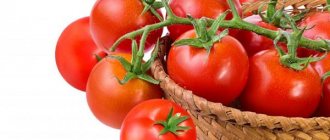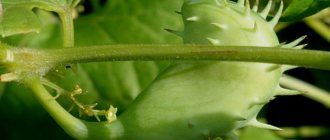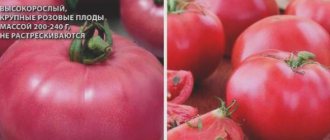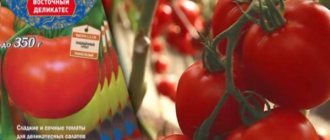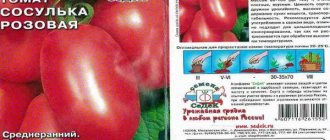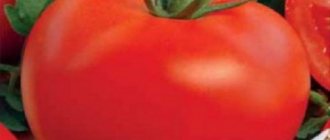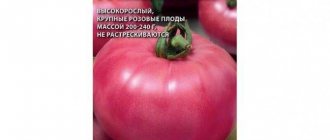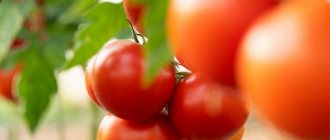The unusual appearance of the tomato Blue bunch F1 will not leave anyone indifferent. Exotic tomatoes hang from the bush in abundant clusters and resemble clusters of grapes. They are added to fresh salads, canned whole, and used for snacks and decoration.
| Height | Landing location | Ripening time | Fruit color | Fruit size | Origin | Fruit shape |
| Tall | Greenhouse, Open ground | Mid-early | Purple | Small | Hybrid | Round |
General description of the hybrid
Blue bunch is a first generation tomato hybrid . This is indicated by the designation f1. It was developed by crossing cultivated and wild tomatoes.
This tomato crop was released for sale quite recently. It is not included in the Russian register, but has already gained popularity among gardeners around the world. Domestic companies also produce this tomato.
Note ! Seeds from hybrid fruits are not suitable for sowing.
Distinctive features of the Blue Brush
The main distinguishing feature of the Blue Brush tomato is the unusual color of the fruit.
Its berries are deep blue. Because of this, they resemble ripe plums. These tomatoes are classified as cherry tomatoes. They are miniature and are formed by brushes.
A characteristic feature of the Blue brush is its high shelf life. Ripe fruits are stored for several months.
The taste of the berries is also very unusual. It is sweet, with a slightly pronounced sourness. Tomato notes are combined with a plum aftertaste.
Blue cherries are suitable for fresh consumption. When preserved, the fruits do not crack, but change their beautiful blue hue to brownish-brown.
Let's note the benefits of dark blue fruits. They contain a strong antioxidant - anthocyanin. Contains other beneficial substances. Thanks to this composition, Blue Bunch has the ability to cleanse blood vessels, improve heart function, have a positive effect on the condition of skin and hair, and improve immunity.
A negative feature of an exotic hybrid is the difficulty of growing it. It needs to be shaped, pinched and tied. The choice of location for beds with such tomatoes and feeding is important. If the agricultural technology of the Blue Bunch is violated, the fruits turn out to be hard and tasteless.
Despite its unusual appearance, the Blue Bunch has a high immunity to tomato diseases. This hybrid does not even affect late blight, which is considered one of the most dangerous and widespread diseases of tomatoes.
Characteristics
The characteristics of the Blue Bunch tomato will impress experienced gardeners. It will be quite difficult for beginners to grow such a hybrid.
Description of the hybrid:
| Parameter | Indicators |
| Bush type | Indeterminate hybrid. They reach a height of 1.5 m. The stems are thick and powerful. The bushes are not spreading, but they form a lot of shoots. The bush is covered with an average number of leaves. The leaves are bright green, medium in size, with a small amount of fluff. The first inflorescence is formed at the level of 7-9 leaves. Subsequent ones after 1-2 sheets. The flowers are simple. Fruits are produced in clusters |
| Growing method | Not resistant to cold weather. In our country it is mainly grown in greenhouses. In the southern regions, planting in open ground is possible. |
| Productivity | Average. From 1 sq. m get up to 7 kg of fruit. |
| Fruit | Cherry. The average weight of one berry varies from 20 to 50 g. In rare cases, specimens weighing 70 g are found. Unripe fruits are not green, but blue. Ripe berries have a rich dark blue color. There is usually a red or orange flank. The flesh is red, without green spots. The fruits are juicy, with medium fleshiness. The shape of the berries is round, without pronounced ribbing at the base. The taste is sweet, with unexpressed sourness and plum flavor. There is a characteristic tomato aroma. Inside each berry there are 2 chambers with a small amount of seeds. |
| Transportability. | High. The fruits have a tough skin and can be transported over long distances. |
| Ripening time | Mid-season hybrid. The fruits of the Black Bunch ripen by August. Some manufacturers position it as early ripening, but gardeners deny this information. |
| Disease resistance | Tomato is resistant to most diseases. Does not suffer from late blight. |
Growing seedlings
The blue bunch in our country is grown by seedlings. Seeds are sown 2 months before planting tomatoes in the ground. Planting seedlings to a permanent location is possible when the soil warms up.
In most regions, seeds are sown in March. In this case, you need to familiarize yourself with the indicators of the lunar calendar.
Seed preparation
To get healthy seedlings, you need to properly prepare the planting material. There are several mandatory pre-sowing steps:
- Checking planting material for germination. Before purchasing seeds, check their expiration date. At home, the seeds are soaked in a saline solution. To do this, add a teaspoon of salt to a glass of water. After half an hour, the floating specimens are collected and thrown away. Those seeds that have sunk to the bottom are washed and used for sowing.
- Seed dressing. This procedure will disinfect planting material, reducing the risk of plant disease. To do this, the seeds are soaked in a solution of potassium permanganate, soda or Fitosporin. Aloe juice is also considered effective.
- Growth stimulation. This step is necessary to speed up seed germination. As a stimulant, they use either purchased products, for example, Epin, or homemade preparations, for example, honey water.
Note! Manufacturers often treat expensive and rare seeds in a factory setting. This will be indicated by the inscriptions on the packaging and the green or orange color of the planting material.
Selection of container and soil
To sow seeds in the usual way, use large, shallow containers. They are bought in a specialized store or made from improvised materials.
After the true leaves appear, the seedlings are planted in individual containers. For this purpose, pots and cups with a volume of at least 300 g are used.
Homemade containers are in no way inferior to purchased options. When using scrap materials to plant seeds, be sure to make drainage holes.
All containers that will be used for growing seedlings are treated with a disinfectant solution. To do this, it is soaked in a solution of potassium permanganate, in copper sulfate or wiped with alcohol.
Advice ! Blue bunch is an expensive and rare hybrid. Therefore, it is advisable to grow it in peat tablets. This method allows you to achieve the best germination of seeds.
The soil for tomatoes is chosen to be light, nutritious and slightly acidic. To achieve the ideal composition, humus and black soil are mixed in equal proportions. Peat, sawdust, crushed coconut fiber or sand are used to loosen the substrate. Using ash, soil acidity is reduced. Superphosphate will help make the soil more nutritious.
A suitable soil mixture is also sold in the store. Select soil for tomatoes and peppers.
Before use, the soil is treated. To do this, water it with a solution of copper sulfate or potassium permanganate. Another option for soil disinfection is calcination in the oven at 100°C.
Sowing seeds in peat tablets and boxes
Most often, seeds are sown in the usual way. To do this, water the soil in the boxes generously. Grooves are made in it for seeds 1 cm deep and at a distance of 2 cm from each other.
Seeds are placed in the depressions at a distance of 1.5 cm from each other. The planting material is covered with a layer of soil on top.
The boxes with seeds are covered with film and placed in a warm place. Depending on the room temperature, germination times vary from 3 to 7 days.
When growing seedlings in peat tablets, another technology is used:
- The tablets are placed in a deep container with the holes facing down. After this, pour in enough boiling water to lightly cover the workpieces.
- When the liquid is absorbed and the tablets swell, add the same amount of water to the container. The tablets should expand even more.
- Then the peat blanks are removed from the container. One seed is pressed into each of them with a toothpick.
- All peat tablets with seeds are placed in one container. It is covered with film and put in a warm place.
Seedling care
It is not difficult to grow seedlings if you follow the basic rules for their care:
- The film on containers with seeds creates conditions of extreme humidity. Such conditions are considered ideal not only for planting material, but also for sprouted plants during the first 7 days. Therefore, after the tomatoes germinate, the film is not removed, but only opened slightly every day for several hours for 7 days. Then the improvised greenhouse is dismantled.
- Water the seedlings as the soil dries out. It is important that water does not get on the greenery of the plant. The liquid for irrigation should be at room temperature.
- I pick tomatoes after two true leaves appear . They are carefully removed from the pots, being careful not to damage the root system. It is important not to deepen the plants so as not to cause the stems to rot. A layer of drainage is placed at the bottom of individual containers for transplanting tomatoes.
- During the entire period of growing seedlings, three feedings are done. The first - two weeks after picking, the last - 3 days before planting tomatoes in open ground, and the second between 1 and 3. Complex mineral fertilizers or vermicompost are used for seedlings. It is important that the last fertilizing includes phosphorus.
Advantages and disadvantages
Pros:
- extraordinary appearance and excellent taste;
- commercial qualities;
- transportability;
- shelf life up to 25-30 days;
- endurance to temperature fluctuations;
- high level of beneficial components (antioxidants and anthocyanins);
- tolerance to stressful situations;
- uniform cluster fruiting;
- stable productivity;
- versatility of cultivation.
Minuses:
- the importance of forming vigorous bushes.
Growing tomatoes
Blue bunch is grown mainly in a greenhouse. Therefore, in most regions, planting plants in a permanent place is possible already in mid-March.
In the southern regions, the hybrid is also planted in open ground. Depending on the outside temperature, this is done at the end of April or in the first half of May.
Planting tomatoes in a permanent place
The beds for tomatoes are prepared in the fall. They are cleaned of plant residues. The soil is mixed with mullein, humus or other organic fertilizers. To reduce the acidity of the soil, dry lime is added to it.
In the spring, the beds are dug up again. Check the acidity of the soil. If it is still elevated, this is corrected with ash. All roots that have managed to form during this time are removed.
Then holes are dug. They are placed in rows in a checkerboard pattern. For 1 sq. m plant no more than 4 plants. 1 tbsp is poured into each hole. l. granular mineral fertilizers or ash.
3 days before planting, the seedlings are watered and fed. When the time comes for picking, it is removed from the pots and placed in the holes. The plants need to be buried a little, tearing off the lower leaves.
After this, the tomatoes are watered generously. Up to 1 liter of water is used per bush.
Plant care
Blue bunch bushes reach 1.5-2 m. Therefore, they definitely need to be tied up. For these purposes, wooden supports or plastic trellises are used. Plants are tied up as they grow. Only synthetic thread is used to avoid stem rotting.
It is necessary to form a blue tomato. Gardeners advise leaving 1 or 2 stems. In this case, the harvest will be good, and the fruits will have time to ripen before August.
Stepping is carried out regularly. During this procedure, not only excess stepsons are removed, but also wilted lower leaves.
The soil is moistened as it dries. Watering should be plentiful, but infrequent.
Mineral and organic fertilizers are used to feed tomatoes. Mullein or chicken droppings diluted with water are used as organic matter. Mineral fertilizers are purchased in stores.
Mineral and organic fertilizers alternate. If long-acting mineral granules have been added to the holes, then the first mineral supplements are skipped.
During the season, plants are sprayed with foliar compounds twice. To do this, use fertilizers that include iodine.
Nuances of caring for the Blue Bunch
The Blue Bunch tomato is demanding of care. To get a bountiful and tasty harvest, you need to know several nuances of growing this hybrid:
- The fruits of this hybrid turn blue precisely under the influence of sunlight, and this factor also affects their taste. Therefore, for such tomatoes, choose the most illuminated area of the garden. In a greenhouse, the roof should be transparent. The lack of light is compensated with special lamps.
- The blue bunch is demanding on the composition of the soil. These tomatoes are fed every two weeks.
- Be sure to regularly loosen the soil of tomatoes. Do this after each watering. Otherwise, due to impaired air exchange, the yield of the hybrid will significantly decrease.
Diseases and pests
The Blue Bunch hybrid is highly resistant to most tomato diseases. Despite this, it is important to follow the basic rules for preventing such diseases:
- Processing of planting material, soil and garden tools. When growing tomatoes in a greenhouse, the walls of the room are also treated.
- Compliance with crop rotation rules . Tomatoes are not planted in beds where nightshade crops previously grew. It is not recommended to grow tomatoes in one place for more than 2 years.
- The right neighborhood . Potatoes should not be planted near tomatoes. Crops with different care requirements cannot be grown in one greenhouse.
- Compliance with the rules of watering and pinching. These procedures are not carried out during the hot part of the day.
- Removing weeds. Weeds are considered carriers of pathogens.
- Preventive spraying . To do this, use “Fitosporin”, “Bordeaux mixture”, and a solution of potassium permanganate.
Pest protection. Large beetles are collected by hand. Get rid of small ones by spraying the bushes with a soap solution and infusion of pure celandine.
Features of agricultural technology for exotic vegetables
Principles of agricultural technology for these tomatoes:
- Tomatoes are planted in the garden as seedlings, which begin to be grown 60 days before planting;
- seedlings are placed in the main place no earlier than March;
- when planting, place up to 4 bushes per 1 m²;
- tomatoes are planted until 1–2 stems are formed;
- all tomato stems are tied up;
- remove foliage that prevents light from reaching the fruit.
The nuances of growing in open ground and in a greenhouse
Blue bunch is mainly grown in a greenhouse. Before planting plants in such conditions, the room is treated with a disinfectant solution.
In a greenhouse, the issue of maintaining optimal humidity is relevant. To do this, open the windows in the room every day.
In open ground, tomatoes are covered with film overnight for the first two weeks after picking. If there is a cold snap during the summer, the plants are covered during the day.
Mulching the soil in open ground is mandatory. It will protect plant roots from cold, pests and diseases.
Pests and diseases
Like many other hybrids, the plant is resistant to most tomato diseases. However, since there is a possibility of infection, it is necessary to provide preventive treatment measures against viral and fungal diseases:
- Treat seeds in disinfectant solutions before planting.
- Follow the rules of crop rotation - plant in areas where tomatoes, potatoes or other nightshades have not grown over the past three years.
- When growing a plant in a greenhouse, it is necessary to treat the greenhouse itself and the soil inside it.
- During the entire growing season, spray with phytosporin, treat with copper oxychloride or Bordeaux mixture if late blight is likely to appear.
The main pests of tomatoes - slugs, whiteflies, spider mites, and Colorado potato beetles - oppress the foliage and can be detected by careful inspection of the plants. There are a large number of drugs against them.
In small areas, summer residents consider it safer to spray with decoctions of wormwood, dandelion, ash, or simply wash the leaves with a solution of laundry soap. Colorado beetles and slugs can be collected manually, but this procedure should not be delayed, since the larvae cause much more harm than the beetles themselves.
If there is a noticeable lag in plant growth, and there are no other external signs of the disease, check to see if the roots of the tomato are being undermined by wireworms or May beetle larvae, which often end up in the area with compost or manure.
Reviews from gardeners
Reviews from gardeners about the Blue Bunch tomato are mixed. Many are dissatisfied with their whimsical care and unusual taste of the fruit.
Galina Kireeva, Belgorod: “I planted the Blue Bunch because of the extremely unusual color of the fruit and the promised pronounced fruity aftertaste. Formed into three stems. Grown in open ground. I fed it 3 times during the season. The result was not impressive. The fruits had small blue areas and tasted tasteless. I suspect they haven’t had time to ripen.”
Irina Lebedeva, St. Petersburg. “I’ve been growing several Black Bunch bushes in a greenhouse for two years. Yes, you have to tinker with the tomato. I form tomatoes into one stem, feed them every two weeks, and use additional lighting in greenhouses. But it's worth it. The tomatoes are dark blue, as in the photo. The taste is sweet with a tomato-plum aroma. Good for salads. They are stored almost until the New Year. I determine the ripeness of the fruit by the red area on one side. I noticed that the more sun the fruits receive, the darker their shade. The price, of course, is not budgetary - 150 rubles for 10 pieces of seeds.”
Characteristics and description of the Blue Bunch tomato variety, its yield
Tomato Blue Bunch f1 is a very interesting variety, obtained by crossing and selection, so named for its beautiful shape and dark color. It grows in clusters on the bush. The tomatoes are a deep grape blue shade. It is sometimes compared to plums.
This exclusive is surprisingly healthy when eaten fresh, and you can also make sauces, pastes, and bake from it. Thanks to its sweet, rich taste, some people make jam from it. It is characterized by high yield and does not crack during transportation.
About the characteristics of tomatoes
This crop is a hybrid obtained by crossing wild tomatoes with domestic ones. Wild ones have a dark tint. This is one of the most unique varieties, developed specifically for lovers of unusual vegetable colors. When planting, new seeds are used each time. The variety grows well throughout Russia and is resistant to cold and disease. However, it is still better to plant it as seedlings in greenhouses.
The description and characteristics of the variety are given on the seed packet. They allow you to determine how best to grow a given hybrid in order to achieve a large harvest.
The bushes are usually tall, the stems are thick and powerful. Curly shoots with tassels come from it. The foliage is bright green, carved, without fluff. The flowers are simple.
One of the reasons why it is worth growing this vegetable is the unusual taste of the fruit; it is not like the tomatoes that many are so accustomed to. Some gardeners describe it as a mixture of plum and tomato. They are round, smooth, shiny. Ripe tomatoes are almost black or dark purple in color, while unripe tomatoes range from green to blue. The flesh is very fleshy and juicy, the skin is dense. They usually grow in clusters on branches.
These tomatoes are very healthy. They contain many vitamins that improve attention, memory, protect blood vessels, the heart, and cleanse the blood. They can be given to children calmly, without fear of allergies. They improve metabolism, increase immunity, and also remove harmful substances from the body.
Growing rules
These tomatoes are usually planted in the garden as seedlings with strong foliage. But first, the seeds are germinated on the window in March. It is necessary to maintain a distance of two to three cm between the seeds. During the growth process, it is better to plant the shoots in separate containers.
In two months, ready-made sprouts should appear and are planted in the garden. It is better to tie up the bushes immediately. The soil in the greenhouse is prepared in the fall. Before planting, it is plowed, loosened, sprinkled with fertilizer, and watered. Immediately after all the seedlings have been planted, it is better to leave them alone for several days to adapt to the new place. From the moment the seeds are planted until the fruit ripens, it usually takes three months.
It is best to try to grow the bush into one branch the first time. Do not let it grow too thick; if there are excess shoots, they need to be cut off.
Reviews about this culture are very diverse. Some people don't really like it because of its non-standard taste. Some people, on the contrary, want something original. Its main advantages are that it has strong immunity, is not afraid of cold weather, and produces a large harvest.
The secret to a good harvest is simple. If a summer resident wants to grow unusual types of crops, then he needs to be more careful about caring for them.
How to care
The taste of ripe plums in combination with tomatoes depends on the quality of care. If there is not enough light, nutrition, or watering, the fruits will become sour, hard, and their color will fade. They will not be able to mature to the required stage. Therefore, you need to clearly know what conditions need to be created for them.
- Before planting, seeds are dipped in a solution of potassium permanganate and in a means to accelerate growth;
- The soil needs to be constantly loosened. This will improve the supply of nutrients, water and air;
- Be sure to add fertilizer two weeks after planting in the greenhouse, and then every three weeks;
- To prevent diseases and pests, it is necessary to periodically spray the bushes with special means;
- Weeds suck strength and nutrients from tomatoes, so they always need to be weeded, removing them by the roots;
- Tall bushes need to be tied with ropes;
- In order to have more light in the greenhouse, excess foliage should be removed, and when planting, take into account the distance so that the seedlings do not grow densely;
- Doors and windows should be opened on hot days to add fresh air;
- It is enough to do pinching once every two weeks;
- Provide high-quality watering; all tomatoes need moisture, but do not overwater them.
Video: Caring for tomatoes. First important steps
Blue tomatoes are one of the most interesting nightshade crops for gardeners. They have an original color and often have an unusual taste. These fruits contain anthocyanin, a powerful antioxidant. In addition, such tomatoes are less allergenic than red ones, so they are allowed to be included in children's diets.
There are dozens of varieties and hybrids with dark fruits. And the brightest color among them is the Blue Bunch tomato. The brushes of this hybrid are strewn with small blue cherry tomatoes. Read on to learn how to grow such a miracle in your garden.
Further care
Watering plants
The culture tolerates hot and dry weather well. Therefore, it is recommended to water tomatoes once every 2 weeks. It is important to ensure that the soil does not become too waterlogged. Otherwise, late blight may appear. It is also not recommended to water the plants frequently due to the greatly overgrown green mass. It may begin to rot, which will lead to a decrease in yield.
READ MORE: Do-it-yourself recreation areas at the dacha photo
Top dressing
The Blue tomato responds well to fertilizing. Due to the large height of the bushes and abundant green mass, it needs fertilizers.
The first time feeding is carried out when ovaries begin to appear on the bushes. It is recommended to use a solution of wood ash or superphosphate.
The next time the plants are fed with potassium fertilizers is when the fruits begin to actively grow. This will allow them to develop qualitatively and increase productivity. Potassium will give tomatoes a pleasant taste and aroma and will contribute to longer storage of fruits after harvesting.

